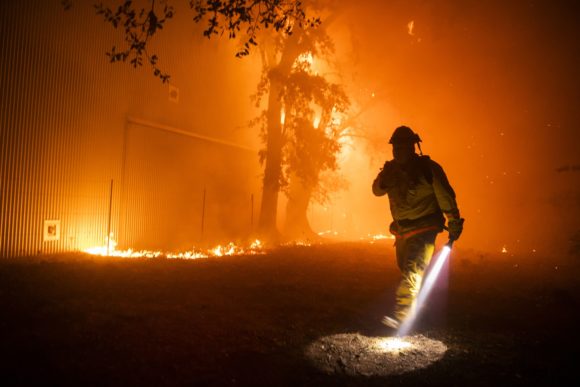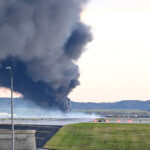Less than a month after emerging from bankruptcy triggered by a string of devastating wildfires in 2017 and 2018, PG&E Corp. has now been found responsible for California’s biggest blaze of 2019.
The California energy giant’s power lines sparked the Kincade fire which burned 77,758 acres and destroyed 374 structures in Sonoma County wine country, the California Department of Forestry and Fire Protection, said Thursday.
Investigators have sent a report on the incident to the Sonoma County District Attorney’s Office, only a month after PG&E pleaded guilty to 84 counts of involuntary manslaughter for a 2018 conflagration that was the most deadly in state history.
Brandon Gilbert, an assistant to Sonoma County District Attorney Jill Ravitch, didn’t immediately respond to an email and phone call seeking comment. PG&E didn’t immediately respond to a request for comment.
PG&E’s equipment was long suspected of causing the Kincade fire that started on October 23, as the utility had reported that one of its transmission lines malfunctioned near the location and time of the start of the blaze. The company said in May that it could book a loss of at least $600 million stemming from damages tied to the wildfire.
PG&E shares fell nearly 2% in after-market trading.
The Kincade fire likely won’t cause the same kind of financial trouble for PG&E as the string of catastrophic blazes in 2017 and 2018 that were blamed on its equipment and pushed it into bankruptcy more than a year ago. PG&E estimated liabilities from those fires at $30 billion. The company emerged from Chapter 11 at the start of this month after having settled claims from the earlier fires for $25.5 billion. The Kincade blaze wasn’t included in the bankruptcy settlement with victims.
Even before Cal Fire’s report, PG&E faced lawsuits over Kincade. One of the suits, filed July 8 in Sonoma County Superior Court, was filed on behalf of a golf course, vineyards and a hotel damaged in the fire. The suit blames PG&E’s culture as the cause, claiming it failed to maintain aging equipment despite knowing it was unsafe.
The fire started after PG&E had shut down other power lines in the area during windy and dry conditions. The measure was part of a number of intentional blackouts carried out by PG&E in October designed to keep its equipment from sparking another calamitous blaze.
Mike Danko, a lawyer representing victims of the Camp fire in Paradise, California, in which PG&E pleaded guilty to involuntary manslaughter, said Cal Fire’s report was unsurprising. Danko is representing a number of individuals and businesses who lost property from the Kincade fire.
“We knew that, just like the Camp Fire, PG&E should have turned the transmission lines off, but didn’t,” he said, referring to the Kincade blaze. “The only question is, given what happened in Paradise, why did PG&E leave the transmission lines energized? Did it learn nothing at all?”
About the photo: A firefighter uses a flashlight to search the perimeter of a building at the Soda Rock Vineyards during the Kincade fire in Healdsburg, California, U.S., on Sunday, Oct. 27, 2019.
Was this article valuable?
Here are more articles you may enjoy.


 NYC Sues Delivery App Over Lost Pay in New Mamdani Crackdown
NYC Sues Delivery App Over Lost Pay in New Mamdani Crackdown  OpenAI And Microsoft Sued Over Murder-Suicide Blamed on ChatGPT
OpenAI And Microsoft Sued Over Murder-Suicide Blamed on ChatGPT  Tesla, EEOC Plan Talks to Settle Factory Racism Suit
Tesla, EEOC Plan Talks to Settle Factory Racism Suit  Boeing 2011 Warning May Offer Clues into 2025 UPS Jet Crash
Boeing 2011 Warning May Offer Clues into 2025 UPS Jet Crash 